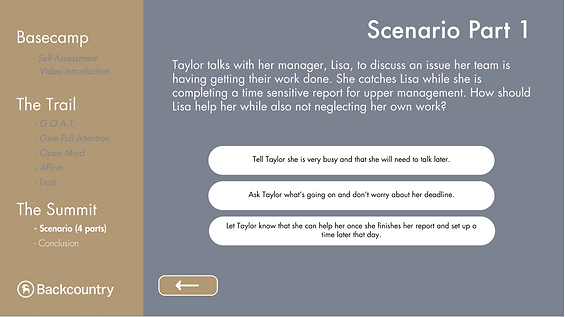
Instructional Design
Know the Audience. Understand the Need.
Develop & Design the Content.
Create the Solution to the Problem.
Bridgerland Technical College
Module for Instructors
Description:
A group of graduate students in the Instructional Technology and Learning Sciences masters program developed and designed this module as part of the Instructional Design I course. Shannon Sandau, Cooper Sanders, Lindsey Soffe, and I collaborated to facilitate that work.
The goal of the module is to teach instructors at Bridgerland Technical College (BTECH) about cognitive load and help them improve their course content. Defining cognitive load, analyzing the role of memory, and providing a specific remedial strategy of chunking all came together to fulfill this purpose.
The module lives in the Canvas LMS as a part of an Instructor Training course.
Needs Analysis & Goal
The primary goal of the module is to improve instructor's knowledge of cognitive load and related topics and provide specific tools to help them develop content which supports their students' progression through and retention of course material.
The leadership of the Instructional Systems Design Department at BTECH identified this module as a need. Having an understanding of cognitive load is foundational to developing high-quality learning experiences and impacts all curriculum at BTECH. Two group members worked at BTECH and as a team we discussed these needs and the desires of the department leadership.
Task Analysis
The following table illustrates the tasks we felt necessary to satisfy the goal of the module.

Learner Analysis
This module is made for instructors at Bridgerland Technical College. As a group we conducted a learner analysis to understand their characteristics and needs. Below is a table outlining characteristics of the current instructors at BTECH.

Instructional Goals & Objectives
With the former analyses in place, we developed the following goal and objectives for the module. We ensured that the objectives were clear and measurable using Bloom's Taxonomy.
Main Instructional Goal:
Bridgerland instructors will develop a foundational understanding of cognitive load theory, describe how cognitive load impacts student learning and curriculum design, and apply a cognitive load-reducing strategy (chunking) to improve student comprehension and reduce cognitive load.
Objective 1: Define Cognitive Load Theory.
Instructors will be able to:
-
Describe cognitive load theory and cognitive load.
-
Explain the basic components of the working memory model.
Objective 2: Identify the impacts of cognitive load.
Instructors will be able to:
-
Compare and contrast high- and low-cognitive load instructional strategies.
Objective 3: Apply cognitive load-reducing strategies.
Instructors will be able to:
-
Explain how to use chunking strategies.
-
Implement a low-cognitive-load teaching technique (chunking content) in an existing course.
Creating the Module
With the goal and objectives defined, we drafted the module in the Canvas LMS. In this process we had two iterations. After a first draft was complete we received feedback from BTECH stakeholders and then created a second iteration. Below, you will find screenshots of the polished module.
Module Outline:

Module Overview:
This page introduces the learner (the instructors) to the module and orients them to the objectives of the module.

Content Page on 'Cognitive Load':
This page introduces the learner to cognitive load. It gives them a brief explanation and provides examples of how cognitive load can be increased or decreased.




Content Page on 'Role of Memory':
This page teaches the learner about memory and how it is connected to cognitive load.



Content Page on 'Chunking a Page':
This page begins the teaching on a specific strategy to reduce cognitive load called "Chunking." It goes over breaking down a page into different sections.

Content Page on 'Chunking Content':
This page continues the teaching on a "Chunking." It goes using different formatting strategies to reduce cognitive load.


Cognitive Load Quiz:
To evaluate the learner's understanding of concepts, we include a formative assessment in the form of a quiz. Below is a screenshot of the quiz instructions, followed by two quiz questions.


Cognitive Load Activity:
To demonstrate proficiency in the concepts, the learner also completes an activity. Within the module is a poorly-constructed page of content which the learner will edit using chunking techniques. The learner will then meet with an Instructional Designer at BTECH and explain the changes he or she made. This allows the Instructional Designer to evaluate if the learner correctly chunked a page and understands how cognitive load affects curriculum.


Cognitive Load Activity Page:
Below is the poorly-constructed page the learners are asked to edit.

In Conclusion
Bridgerland Technical College aims to provide quality learning experiences for its students, helping them succeed in the classroom and later in their careers. As a part of the strategy to do this, BTECH supports its teacher in their development too. As part of the Instructor Training course, this module provides valuable knowledge and insight on cognitive load and related ideas and stratgies to produce and organize better course content. This allows the students grasp and retain key concepts and perform better in their courses and progress faster in education and career pursuits.
Backcountry.com
Leadership Training Course
Description:
A group of graduate students in the Instructional Technology and Learning Sciences master's program at Utah State University developed and designed this course as part of the "Design Thinking" class.
The goal of the course is to teach managers and other corporate leaders in the Backcountry.com organization the soft skill of active listening and help them increase their capabilities as a leader. The content is meant to be easy, approachable, and quick while still giving applicable information and advice.
The version of the course here is a mockup using Adobe XD. The actual course was built in Adobe Captivate.
Needs Analysis & Goal
The primary goal of the course is to increase manager's understanding of active listening and improve their ability to use this soft skill. The team came to understand this need through a conversation with the key stakeholder at Backcountry.com.
Task Analysis
The key content for this course is threefold: 1) a pre-course assessment to help managers gauge where they are at in their development of the skill, 2) core content organized in a way that would help managers remember what they learned, and 3) an evaluation where managers can apply what they have learned to given scenarios.

Learner Analysis
This course is made for managers and leadership at Backcountry.com--many of these are first-time managers. As a group we conducted a learner analysis to understand their characteristics and needs. Below is a graphic outlining characteristics of what a first-time manager might look like at Backcountry.com

Instructional Goals & Objectives
A weakness in the implementation of this course is a lack of communication of the goals and objectives of the course with the learner. This project was done as part of Design Thinking, rather than an instructional design course itself. However, here are the goals and objectives.
Main Instructional Goal:
Backcountry managers will develop a foundational understanding of active listening as a leadership soft skill and be able to use strategies to be a better listener and communicator with their team.
Objective 1: Identify where they stand in their development of active listening.
Objective 2: Explain four concepts which will help them to be better listeners.
Objective 3: Apply information and strategies to scenarios.
Creating the Course
The course was first created in Adobe XD as a mockup and then remade in Adobe Captivate. I led the team in paying special attention to the branding and culture of Backcountry.com to help make the content more approachable and memorable, creating the course outline patterns (Basecamp, G.O.A.T. etc.) along with the look and feel.
One of the main differences between the mockup and final product is the way the Self-Assessment was created (yes or no vs. a Likert scale) and a Self-Reflection portion at the end.
The following images are samples taken from the Adobe XD version of the project. Much of the content is the same, but the design is prettier in XD.






After the Pre-Assessment, there is an introductory video which I put together, including the script, animation, editing, and voiceover.
Click through the full Adobe XD version.
or
Watch a run through of the Adobe Captivate version below.
InkLit Education
Creative Writing Course
Description:
Aspiring writers often work on their craft on the side and don't have a lot of time to engage in courses---though they would be highly beneficial. I wanted to create a course that was effective and helpful while still not taking too much time. This course was a personal project and is not associated with an actual company.
Needs Analysis & Goal
The primary goal of the course is to increase writer's understanding of plot through a character-driven story. Central to a good story is the character's experience and growth. Understanding and practicing the interacting components of the plot with the main character is essential for any creative writer. This course addresses this need.
Task Analysis
The content of the course is based on writer Dan Harmon's story circle. It explains the different aspects of the form and also provides an example from a book to illustrate the concepts. To practice the steps, the course asks the learner to apply them to their own story.

Main Instructional Goal:
Writers will develop an understanding of how to construct a plot with the character as the main driving force in the story.
Objective 1: Describe the parts of the Story Circle and how they work together to build a character-driven plot.
Objective 2: Recognize the parts of the Story Circle in a published novel.
Objective 3: Apply the Story Circle to your own manuscript.
Creating the Course
InkLit Education is a made-up entity, created and branded by me. The course was created in Adobe XD as a mockup.
I borrowed ideas of the Story Circle structure from writer Dan Harmon. To complement his teachings, I found quotes from other writers to undergird the ideas and also applied them to an award-winning young adult book, Furia by Yamile Saied Méndez.
Finally, I help the student to apply content of the course to their own manuscripts, breaking down the plots they've created to help identify holes or problems they could have.










